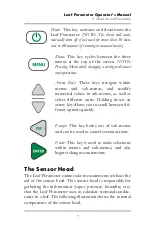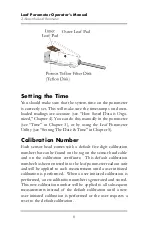
Leaf Porometer Operator’s Manual
3. The Menus
20
will always read low. Discard this reading and begin
recording with the second.
• Avoid leaves that are wet or heavy with dew; never
take readings in the rain.
• Do not cover the white Teflon disk with your finger,
or place your fingers near it, when taking a measure-
ment; this will cause inaccurate readings for several min-
utes.
• If you blow into the sensor head, it will take a few
minutes for the stomatal conductance reading to return
to normal.
• Clean the sensor periodically to keep it free of dirt and
pollen that can build up during use and affect readings.
Chemical Effects
Chemical vapors can interfere with the polymer layers used
to form the humidity sensors. These fumes can diffuse
through the sensor and throw off the sensor’s accuracy. It is
a good idea, therefore, to never bring the sensor into con-
tact with any sort of chemical vapor (i.e. glue, alcohol, gaso-
line, foam). See section on “Sensor Head Reconditioning”
if you suspect your sensors have been affected by chemical
contamination.
Environmental Effects
When making a measurement, the following effects must be
accounted for.
Light.
The amount of CO
2
required for a plant changes
depending on the amount of sunlight available to it. In
broad daylight, more CO
2
is required, so the stomata
remain open. At dusk, the stomata close, and in darkness
they are often closed completely. Readings taken on over-
















































